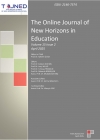TOJNED - Volume 3 - Issue 4 - October 2013
 Academic Misconduct: Student Beliefs and Behaviors at a HBCU
Academic Misconduct: Student Beliefs and Behaviors at a HBCU Timothy J. Sweet-Holp, Veyonnis M. James
Abstract: The purpose of this research is to measure the beliefs and behaviors, concerning academic dishonesty, of students at a Historically Black University (HBCU) located in the Southern United States. A literature review suggests that there is no existing work showing a similar study at a HBCU. Our primary goals are to detail student beliefs and behaviors, and to then better understand the relationship between student beliefs about academic misconduct and their own behaviors. This study uses sixteen questions, measuring various academic misconduct actions, previously asked of students enrolled at a Predominantly White Institution (PWI). Our paper then, in part, compares the findings from the PWI survey to those from our HBCU survey. In addition, our work compares student self reported beliefs to their self reported behaviors. Our data indicate that there is incongruence between beliefs and behaviors; students are more likely to take part in misconduct actions than their reported beliefs indicate.
 Anxiety as Predictor of Aspiration among Academic Achievers
Anxiety as Predictor of Aspiration among Academic Achievers Syeda Farhana Kazmi
Abstract: The present research aimed at to measure the relationship between anxiety and aspiration among academic achievers. A purposive convenient sample consisted of 200 students with average age 15 years of both gender; 100 female students (high academic achievers =50 , low achievers = 50) and 100 male students ( high academic achievers = 50, low academic achievers= 50)were taken from Higher secondary schools of Abbottabad. Taylor manifest anxiety scale (Taylor & Spence,1953) along with Study-Habit Scale( Ansari,1983) were administered on the sample. Analysis of results revealed that the pattern of achievement of a student depends on his/her aspiration level and anxiety has association with level of aspiration in students. Study further highlighted that achievers tend to have considerably higher achievement scores have higher aspiration as the result of perceived high anxiety. Students with low achievement scores have lower aspiration as the result of perceived high anxiety. Least-square line of Regression with achievement status as the outcome of aspiration and anxiety as the predictor variable indicated good model of fit showed that results indicate there was positive significant relationship between students high level of academic achievement and anxiety. The study filled some identified gapes in literature and tries to stress the need for more research on this topic.
 College Readiness and Black Student Performance: Disaffirmed Equity
College Readiness and Black Student Performance: Disaffirmed Equity Carolyn M. Davis, John R. Slate, George W. Moore, Wally Barnes
Abstract: Through a myriad of legislative mandates, College Board endeavors, as well as state and federal incentive programs, efforts to close the achievement gap are visible. As the result of these initiatives, Black students’ involvement in Advanced Placement has increased. However, Black students do not show as much improvement in their Advanced Placement program access and equity as do Hispanic and other student groups. Amid the lens of critical race theory and human capital theory, interest convergence emerges to suggest why a society should educate all of its citizens equally.
 Early Childhood Program Participation and Long Term Effects on Reading Achievement among Boys and Girls
Early Childhood Program Participation and Long Term Effects on Reading Achievement among Boys and Girls Lory E. Haas, Debra P. Price, John R. Slate
Abstract: In this study reading scores for kindergarten through eighth grade students who participated in a Head Start program, center-based care program, or home-based care program prior to school entry were analyzed to determine effects of early childhood program participation on reading achievement for boys and girls. Through analyzing data from the Early Childhood Longitudinal Study-Kindergarten, girls consistently outperformed boys in reading with regard to each of the three early childhood programs. Furthermore, boys and girls who attended a center-based care program prior to kindergarten entry consistently performed higher in reading than boys and girls who attended Head Start or home-based care programs in kindergarten through eighth grade. Evidence was present regarding the importance of center-based care programs to future academic success of students. Implications for considerations for further research are discussed.
 Emile: An Insigh into Education and Citizenship in Pluralistic Society
Emile: An Insigh into Education and Citizenship in Pluralistic Society Rasit Celik
Abstract: This article focuses on the educational aspects of Rousseau’s various works, focusing on the idea of creating a rational citizen. With special reference to Emile and the Social Contract, I argue, beyond the discussion of ‘man or citizen,’ that a general educational ideal which aims at creating free and rational members of an ideal society may be inferred from Rousseau’s educational, social, and political concerns. Rousseau’s concepts such as that of a rational being and freedom are examined to achieve a sense of how an individual becomes a citizen who reasonably and willingly appreciates the general will. Finally, some suggestions are drawn with respect to education for a pluralistic society that may operate under a general will.
 Foundation of the Computer Assisted Translation Act
Foundation of the Computer Assisted Translation Act Ilyas OZTURK, Cemil OZ, Filiz Ă…ĹľAN
Abstract: Mechanical translation (MT) is the transfer of a text from a source language (SL) into a target language (TL) via a cybernetic machine, in other words, “computer”. Human labour, human skills, human experience and human brain power are inevitable in this operation.Mechanical translation is based on word-for-word translation. What occurs in mechanic translation can be summarized as the mutual functioning of SL and TL together, and the achievement of coherence and equivalence in the performed translation. The data are given by humans and the translation is “automated” and mechanized by the computer.With the development of computers, mechanical translation has progressed to a more advanced level in recent years. The recent developed technology has put the polysemy of the words as well as the grammar rules at the disposal of humanity with a developed computer for an optimal translation.This study will show the stages of mechanical translations and the working systems of the projects conducted in this field. On the other hand, sentence-for-sentence-translation, which is the point that normal translation has arrived at, renders the mechanical translation more successful and fruitful. In this way, the contextual meaning of the text gets transferred.The current paper is comprised of the titles of The Realization of Natural Language Elements in Computer, Terminology Formation in Mechanical Translation and Actions Occurring in Mechanical Translation, and mechanical translation is tried to be presented and explained through illustrations and the main elements used.
 Strengthening the Synergy between Teaching and Research
Strengthening the Synergy between Teaching and Research Divya Singhal
Abstract: It is now proved that with the changing context role of management education has become much more important. Teaching-learning process at management education institutions means more than facilitating learning environment and it address the demands and challenges of the knowledge based economy. In the area of management education an ongoing global debate about the teaching-research link is going on. The present paper attempts to answer how research informs teaching and how teaching is informed by research. This paper explores the linkage between teaching and research and suggests ways to strengthening that link. In the first part of the paper it talks about the Research and Teaching relationship; in the second part it discusses the Researchinformed teaching. Last part of the paper deals with the Teaching – inform Research aspect.
 The Effects of Parent’s SES and Education Level on Students’ Mathematics Achievement: Examining the Mediation Effects of Parental Expectations and Parental Communication
The Effects of Parent’s SES and Education Level on Students’ Mathematics Achievement: Examining the Mediation Effects of Parental Expectations and Parental Communication Ali Bicer, Mary M. Capraro, Robert M. Capraro
Abstract: Although there has been prior research concerning parental involvement effects on students’ mathematics achievement, little attention has been placed on the reasons for the mathematics achievement gap between low-and middle-income students, and how to reduce this gap associated usually attributed to students’ SES. The present study’s focus is specifically on parent-child communication and parental expectations mainly because these two variables can increase students’ mathematics achievement despite parental income and education level. The correlation matrix was derived from a national, cross-sectional study of children. The 1997 Child Development Supplement of the Panel Study of Income Dynamics (PSID-CDS) data set was used to analyze the hypothesized model using SEM. The goodness-of-fit indices for the hypothesized model fit well to the data.
 The Use of Technology in Academic Translator Training in the Restructuring Process of Higher Education
The Use of Technology in Academic Translator Training in the Restructuring Process of Higher Education Filiz Ă…ĹľAN
Abstract: As the present age is communication age, the function of translation in this environment is gradually increasing. As a consequence of the developments occurring in the present century, it seems inevitable that translation be performed by means of today’s technological/electronic tools and resources. Accordingly, technological tools have taken their place in translation education as well. The most important reason of this is the expansion of translation fields and the increase in what is expected from the translator. In this framework, the translator is expected to use computer assisted translation tools, to create translation memory, to access information and use resources. In this article, it has been focused on how and for what purposes technological/electronic tools and resources such as computers and computer hardware will be included in translation education within the context of Bologna process for the purposes of gaining these skills and meeting the expectations. In this regard, how the Bologna process is reflected in translation education will also be examined carefully.Translation occupational standards and specifically the use of information technologies have been discussed within the framework of the projected revisions in Bologna process. Besides, the approaches towards the academic translation education have been examined within the scope of this process. In addition to this, parametres necessary for the future of translation education have been determined and some conclusions have been reached for future studies to be carried out in translation.


